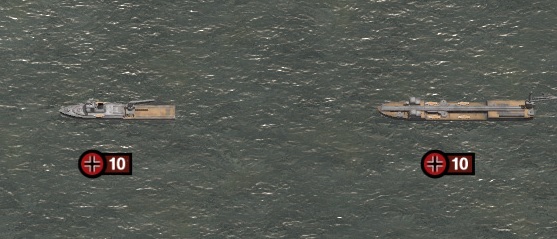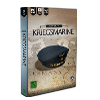Kriegsmarine is the upcoming DLC for the Order of Battle series and it covers the German Navy’s efforts to challenge Allied superiority at sea. From the shores of the Baltic to the deep waters of the Atlantic Ocean, you will lead a smaller varied fleet of destroyers, cruisers and battleships, submarines, seaplanes tenders and carriers, as well as Marines units specialized in amphibious assaults.
This DLC marks, of course, a return to naval mechanics. The team has put a lot of focus in expanding the naval aspects of the series with Kriegsmarine, and to best represent naval warfare they implemented several new features. Let’s look at them, shall we?
Firing efficiency & Hit avoidance
This new mechanic will completely alter how naval combat is played out in the Order of Battle series. Now both movement and range will play a role in damage calculation.
The mechanics already existing in the game dictate that, in order to maximize your damage output, a ship that moves before firing must keep the same distance between itself and its target at the start of the turn and after the move. Basically, if the range stays the same before and after you move your ship, you will have maximized your firing efficiency as you won’t need to calibrate your guns and present the full broadside to the enemy at all times.
This is now combined with new mechanic: By keeping your ship on the run, you make it harder to hit. The more movement points you spend in a turn, the more hit avoidance you will have, and the enemy will deal less damage to you.
The trick is to try to keep the same range between you and your target when firing, but move as much as you can so that you won’t be a sitting duck! In a larger scale naval battle, the trick is to move as much as possible and outside of the effective range of most enemy warships, while still maintaining the same distance to specific targets for maximum firing efficiency.
New Submarines Mechanics
First off, surfaced submarines are now much harder to spot. Previously, they could be spotted by any surface ship or aircraft as long as they were in visible range. Now, they will only be spotted by adjacent ships: this allows brave submarine captains to take risks and gamble. Surfaced submarines can move at a higher speed to close in on merchant convoys or stalk enemy fleets. On the other hand, while a submerged submarine is slower, it can only be detected by sonar.
We also introduced a limited submersion time: now submarines have a battery which they use when they are submerged. For most submarines, it’ll last 3 turns, although for some later models (like the German XXI) it will last 4. Then, the submarine will have to resurface and recharge the battery for a number of turns.
These new mechanics make submarines way more interactive and interesting to play.

The number to the right indicates the battery duration – how long your submarine is allowed to stay submerged!
Primary & Secondary guns split
We decided to split the primary and secondary armaments for battleships and battlecruisers to more accurately portray these vital ships of the era.
Primary guns can only be fired once every 2 turns. Their range and firepower is far greater, meaning that you want to save that when it’ll truly have a significant impact or when a good target is available. That offers an interesting choice to players and adds depth to naval combat. In addition, the secondary guns armament is often equally effective at close range against smaller enemy ships.
Each ship now feels more unique and specialized as well as historically accurate, and there are big differences between various BB types. For example most BB/BC have destroyer calibre guns (100-128mm) but some like the Yamato are armed with (light) cruiser calibre guns (150mm).
Seaplane tenders
In Kriegsmarine we have an entire new class of units, seaplane tenders.
These allow the German Navy to carry and resupply seaplanes (in fact giving it some sort of “prototype-carrier” capability). While floatplanes and flying boats used to be limited to the reconnaissance role, Kriegsmarine adds new types in the offensive role, including floatplane fighters and (torpedo) bombers.

The ship to the left is the AV Greif: it can carry armed floatplanes (like the Arado AR 196 A-3) and resupply floatplanes and seaplane torpedo bombers (like the Heinkel He 59) alike.
The one to the right is the AV Bussard. It can carry and resupply floatplanes and torpedo bombers!
And more!
Kriegsmarine has a lot more to offer, but we don’t want to give away too much info at once. We’re looking forward to you trying the game and finding all the nice little touches that the Artistocrats left there for you to find. But let’s say bye, for today, with one of my favorite new ships.

Everyone who guesses the name of that ship wins a cookie!



 Cart (2)
Cart (2)